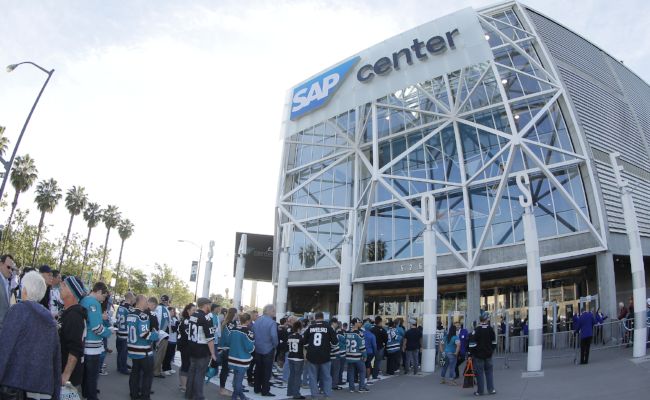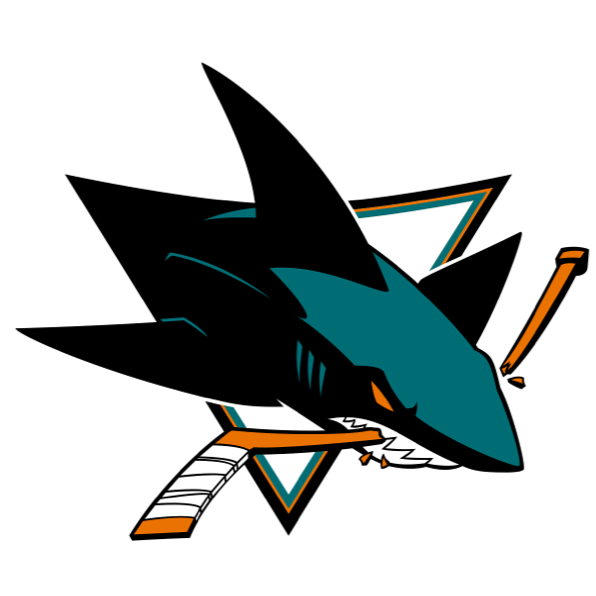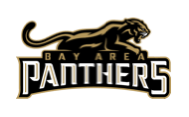
In the beginning, there was Downtown Datsun.
By: Mark Purdy
In the beginning, there was Downtown Datsun.
The automobile dealership squatted there for many years on West Santa Clara St., advertising Great Deals Below Sticker Low Monthly Payments Bad Credit No Problem!!!!!!
Most people drove right past the car lot and exclamation points, barely noticing.
Except that Tom McEnery did notice. As a high school student en route to Bellarmine Prep, he frequently traversed the West Santa Clara St. and Autumn St. intersection on the gritty edge of downtown San Jose. Much later, from 1983 to 1991, he did so as mayor of the city.
This explains why, when talk of building a civic sports arena began to heat up during the 1980’s, McEnery was ahead of the curve. He had just the location. He knew in his gut it was better than others that had been proposed, in North San Jose adjoining Route 237 or at the county fairgrounds.
“In the 1960s and 1970s, so much of downtown San Jose was cleared out for redevelopment,” McEnery now says. “There were blocks full of vacant lots. I had told voters we were going to rebuild it all as an entertainment and business center.”
An arena meshed with that master plan. But if you think that McEnery merely snapped his fingers and magically made the vision come true . . . well, you weren’t around back then.
With the building now known as SAP Center celebrating its 25th anniversary, it can be easy to forget that there was a time when San Jose’s most popular downtown landmark almost didn’t happen at all. Dissenters filed a lawsuit against the plan. A civic referendum was controversial and nearly failed.
In the end, for the building being constructed, you can primarily thank the 73,409 San Jose citizens who voted “yes” on the arena ballot issue in 1988 -- with no promise of any professional sports team ever occupying the venue. But that is still getting too far ahead of the story.
And it’s one hell of a story, with multiple twists and turns involving toxic waste, a Hollywood producer and an Olympic gold medalist. There were multiple twists and turns. At one point, San Jose’s new hockey team was going to be called the “Americans” and wear red, white and blue uniforms. Yes, really.
Everybody knows that the Sharks would not be in San Jose without SAP Center. Many don’t know that getting the building constructed was hardly a breakaway goal. It was more of a grind-it-out task with unexpected crosschecks.
Where to start? Let’s try 1984. A decade earlier, San Jose had passed Oakland in population and would soon be bigger than San Francisco. More and more South Bay residents wondered why they needed to drive 40 or 50 miles north to see major sports and top entertainment.
In response, local trade union executive John Neece floated the notion of an arena at the Santa Clara County Fairgrounds as a possible future home of the NBA’s Golden State Warriors. Neece was also a member of the Fair Board and had an obvious ulterior motive. The plan had no firm financing component. But the idea gained traction and grass roots support.
Example: Over drinks at a downtown tavern, three young sports fans – Sean O’Kane, Tom Colla and Guy Laughridge – decided to pool $500 and print up six dozen silk-screened tee shirts with the slogan: “Fund Arena Now.” Or for short: FAN. Just like that, the first arena booster group was formed. A senior citizen named Chris Panopulos volunteered to be president. A local bank auditor, Bud Genovese, became treasurer. They met regularly to lobby the city council.
McEnery then took the lead, after convincing Neece and the council that downtown was the correct site. He proposed to allocate $100 million in redevelopment money for the arena. Skeptics thought the funds should be spent elsewhere and began gathering signatures for a ballot proposition. McEnery decided to write his own and placed it on the June 1988 ballot.
And then the fight for citywide support began. Things grew ugly. The rhetoric of anti-arena folks went something along the lines of: “Build It And Our City Will Rot In Hell And Possibly Bankruptcy.” McEnery and three of his top staffers—Pat Dando, David Pandori and Dean Munro—did numerous outreach appearances across the city and were peppered with angry questions. So were members of the FAN booster group.
“We set up a booth at the county fair,” Genovese recalls. “Folks came up and said they were against the arena because cars would park where they lived on Shasta Avenue, a mile away. I would argue that no one in California would park a mile away and walk 20 minutes to the arena.”
At a town hall gathering in Willow Glen, McEnery faced the same irate objections.
“I remember saying to them, ‘Gee, it sounds like I’m trying to put a nuclear reactor in the middle of the city,’ ” McEnery says.
Two weeks before election day, the mayor released poll results that showed the arena issue losing. He implored arena supporters to turn out and reverse that trend. He also recruited Olympic figure skating champion Peggy Fleming to write a pro-arena campaign letter. She pointed out it would host many family events as well as sports.
Today, you can’t find anyone who admits to voting against the arena. But on election night 1988, the ballot issue trailed in the early returns. Eventually, approaching midnight, the “yes” votes finally surpassed the “no” votes, winning 53% to 47%.
“I worked that election harder than any when I was running for office myself,” McEnery says. “It was kind of the demarcation point. People in San Jose had to decide whether they wanted the city to keep being so insular and sprawling or wanted to reach out and grasp the future and have a real downtown with major events happening there.”
But what came next? Ice shows, the circus and concert acts were likely to book dates in a new San Jose Arena. For the building to be completely successful, however, an NBA or NHL franchise was needed.
In 1988, the Warriors were not eager to leave Oakland and the NBA only wanted one Bay Area team. The NHL, with only 21 franchises, had no expansion plans. The grass roots began growing again. A downtown attorney named Jim Hager and a young soccer broadcaster named Randy Hahn—yes, the future Sharks’ television voice--formed a “NHL San Jose” advocacy group to begin taking season ticket requests.
Simultaneously, an enthusiastic tech company driver named Joe Frizzi spent his own money to print up a brochure touting San Jose as a potential home for an NHL franchise. Frizzi blindly sent the brochure to league owners and prominent hockey writers. Frizzi was stunned a few weeks later when those same owners suddenly began mentioning San Jose as an expansion possibility.
Yet the first serious hockey interest in the city occurred—of all places—in Beverly Hills. That’s where film producer Howard Baldwin had his office. As a former owner of the Hartford Whalers, Baldwin itched to get back in the game.
“In San Jose, I see a community that is hungry for something like this to happen,” Baldwin said in September of 1989.
After negotiations with the city, Baldwin secured an exclusive negotiating agreement to bring an expansion NHL team that would occupy San Jose’s new arena. He began talks with the league, which was favorable to the idea. Baldwin had a blueprint to corporately brand the building as “American Airlines Arena” with the team being called the “San Jose Americans.”
But wait! Another unexpected plot twist! George and Gordon Gund, owners of the Minnesota North Stars, claimed they still owned NHL rights to the Bay Area. Why? Because the Gund brothers had owned the California Golden Seals, a 1967 NHL expansion team that left Northern California in 1976. Baldwin retrenched and formulated what he called “a global solution.” In the deal, he obtained the rights to buy the North Stars in exchange for the Gunds assuming the San Jose exclusive negotiating agreement.
Neat and clean, right? Not completely.
The Gund brothers were indeed now free to negotiate with San Jose. But they were not obligated to sign any deal. For four months, they considered options in Oakland and San Francisco. In September of 1990, McEnery finally pinned them down and received their commitment in San Jose. It helped that as the Gunds pondered their alternatives, they had hired marketing guru Matt Levine to investigate the marketplace.
Munro, the mayoral staffer who was working on the arena project, fed Levine demographic information that certified San Jose as the best possible Northern California option for hockey.
“After doing all that research,” Munro says, “Matt had become a true believer in San Jose. And that made a big difference.”
The team also finally had a name—the Sharks. At long last, things seemed to be going smoothly. Then the Gund organization took a closer look at the arena plans San Jose had developed with Denver architect Charles Sink.
Frank Jirik didn’t want to be the villain. He had worked for the Gunds in Minnesota, operating the North Stars’ hockey arena for 23 years. The brothers sent him to San Jose with his assistant, Jim Goddard, to examine the proposed arena drawings. They loved the five-story atrium and viewing angles. They did not love the projected capacity (15,000) or the seating (plastic, not cushioned) or the luxury suites (relatively few).
“We went through it all page by page,” Goddard says. “And we came to the conclusion that it was significantly shy of what we needed for an NHL team.”
Jirik, an affably persuasive man, politely informed San Jose officials that their dream arena was not adequate. New negotiations commenced with the Sharks’ Art Savage, the Gunds’ financial manager and future team president.
“We actually negotiated based around what we would build rather than what it would cost,” Goddard says. “And we worked out the cost and who would pay for it after we both had what we wanted to build. When I saw how the city dealt with all that, I knew that we were going to get it done. Both sides took the high road.”
There was another unforeseen problem: A ground survey indicated that a portion of the arena property was contaminated by toxic lampblack, the residue of San Jose’s first oil-burning power plant which had once occupied the site. The answer was to entomb and bury the lampblack in the north arena parking lot, an expensive task. Ultimately, San Jose officials agreed to pony up another $25 million for all the changes and permit the Sharks to operate the arena. In exchange, the Gunds agreed to kick in $20 million of their own.
“If those changes had not been made,” Munro says, “we would have built a structure that was out of date and antiquated within 10 years. It was such a benefit to have the Sharks become the arena operators.”
On a practical basis, however, this meant that the new arena would now open in 1993 rather than 1992. So as the Sharks played their first two seasons at the Cow Palace in Daly City, construction began. Throughout 1991 and 1992, Goddard spent as much time in Denver at the architects’ offices as he did in San Jose. Sink redrew his creation. He pushed up the roof to create more capacity. He expanded the upper deck luxury suites, creating the now-familiar semicircular rings that push out from the sides of the building.
One new feature was implemented because of a car ride conversation. Goddard has a vivid recollection of traveling somewhere with Jirik and Sink. Jirik posed a question to the architect.
“If you could do one thing to improve what we’ve got on the drawing board,” Jirik asked, “what would it be?”
“I’d put terrazzo tile in the concourse,” Sink quickly replied.
Jirik and Goddard looked at each other, nodded and made notes. The concourses were originally going to be polished concrete. The classier-looking terrazzo would be a costly upgrade. But the San Jose Redevelopment Director, Frank Taylor, had bent for quality. He greenlighted the terrazzo. The same with individual urinals rather than trough urinals. The same with a blueprint alteration that moved club seats from the top of the lower bowl to the bottom.
Work continued in earnest. The opening date was scheduled for September 8, 1993, with a performance by the Ringling Brothers Barnum & Bailey Circus.
“Two weeks before the opening, it was down to the wire,” Goddard says. “I remember Frank calling in the various subcontractors and saying, ‘If it looks like it needs to be done, don’t wait to go through the process of asking us and then waiting for us to tell you to do it. Just take care of it.”
The circus came off without a hitch. This became true for the next 25 years, through three name changes – San Jose Arena to Compaq Center to HP Pavilion to SAP Center – and hundreds of events.
With the anniversary celebration underway, it’s a shame that Panopulos, Dando, Jirik, Savage and George Gund are no longer alive to enjoy the festivities. Happily, most of the other principals in the project are still around to do so. Goddard succeeded Jirik as the arena’s vice-president and general manager. Munro believes that if the city had not built downtown in 1986, a private venue would have been constructed 10 years later in North San Jose or Santa Clara. McEnery thinks San Francisco might have built its own arena and become a NHL city.
“It’s still a mini-miracle that it all worked out the way it did,” Munro says.
“I believe the people of San Jose always end up doing the right thing,” McEnery says. “They did so in 1988.”
In other news, Downtown Datsun is not missed.

